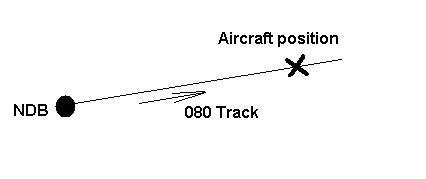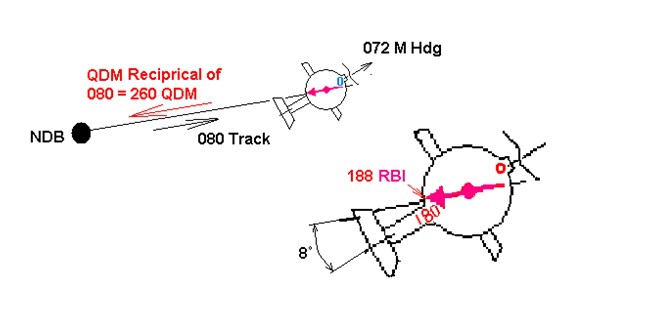


Don’t Think it; Draw it!
Many of the questions set for the com. exams involve the position of an aircraft in relation to the position of one or more beacons. If you read the question in one breath, and then try to imagine the scene in your mind, you will invariably see a confused blur. This is not a reflection of your mind, though we all sometimes do get blurred, but rather a reflection of the method you are employing.
So how do you overcome this?
Always, take plenty of plain paper sheets and a pencil into the exam. This will allow you to draw the question, and then draw the answer.
Read the question once - through to the end - and make sure you know what the question is really about. In my com. class, which I give through various ground schools, I have one question that demonstrates how easy it is to miss the real question, and instead, answer what you expect the question to be. Remember RTFQ (that’s ‘Read The Full Question’ for those who thought it meant something else), then go back to the beginning and try to break the question into its component statements.
Draw everything you understand, i.e. look at the following question::
Q1. An aircraft is tracking 080º outbound from an NDB. The aircraft is heading 072º. What is the indication on the RMI and RBI?
This can be broken down as follows:
An aircraft is tracking 080º outbound from an NDB. Before you read any more of the question, you can draw an NDB in the middle of the paper and draw the track, out from the NDB at 080º and place a mark on the track representing the position of the aircraft. To draw the correct bearing, assume north is pointing to the top of the paper. A protractor will come in handy for this.
Many of the questions set for the com. exams involve the position of an aircraft in relation to the position of one or more beacons. If you read the question in one breath, and then try to imagine the scene in your mind, you will invariably see a confused blur. This is not a reflection of your mind, though we all sometimes do get blurred, but rather a reflection of the method you are employing.
So how do you overcome this?
Always, take plenty of plain paper sheets and a pencil into the exam. This will allow you to draw the question, and then draw the answer.
Read the question once - through to the end - and make sure you know what the question is really about. In my com. class, which I give through various ground schools, I have one question that demonstrates how easy it is to miss the real question, and instead, answer what you expect the question to be. Remember RTFQ (that’s ‘Read The Full Question’ for those who thought it meant something else), then go back to the beginning and try to break the question into its component statements.
Draw everything you understand, i.e. look at the following question::
Q1. An aircraft is tracking 080º outbound from an NDB. The aircraft is heading 072º. What is the indication on the RMI and RBI?
This can be broken down as follows:
An aircraft is tracking 080º outbound from an NDB. Before you read any more of the question, you can draw an NDB in the middle of the paper and draw the track, out from the NDB at 080º and place a mark on the track representing the position of the aircraft. To draw the correct bearing, assume north is pointing to the top of the paper. A protractor will come in handy for this.
The aircraft is heading 072º. With this information, you can draw the shape of the aeroplane over the
previously drawn position mark on the track, showing the aircraft’s nose (I always add a prop.) directed
towards 072º. Having done this, it will become obvious from the drawing that the aircraft has its nose turned
to the left of track. You can assume the pilot is correcting for 8º of right drift. I.e., the aircraft would drift off
track to the right if the correction were not made.
What is the indication on the RMI and RBI?
RMI (Radio Magnetic Indicator). As you have learnt, the RMI indicates QDM’s. The QDM can be represented by a line drawn from the aircraft to the beacon. The line is already drawn. It’s the previously drawn track, except it’s in the opposite direction when considering the QDM. In fact it’s the reciprocal of the 080º track; 260º QDM.
RMI (Radio Magnetic Indicator). As you have learnt, the RMI indicates QDM’s. The QDM can be represented by a line drawn from the aircraft to the beacon. The line is already drawn. It’s the previously drawn track, except it’s in the opposite direction when considering the QDM. In fact it’s the reciprocal of the 080º track; 260º QDM.
RBI (Relative Bearing Indicator). The RBI indicates relative bearings. I.e., the degrees measured from the
nose of the aircraft to the beacon. To envisage this, I advise my students to draw the Relative bearing
indicator on the back of the aircraft as I have done hear. From your drawing, you can see that the beacon is
just to the left of the tail (from the pilot perspective) . In fact 8 º. to the left. Measuring from the nose (0 /
360), clockwise, the tail is at 180º. The RBI needle will point to the beacon, which is 8º beyond the tail; i.e.,
188º.RBI.
This may have been a relatively simple question, but, most questions when broken down into component parts are just as simple.
This may have been a relatively simple question, but, most questions when broken down into component parts are just as simple.
CPL Assist
